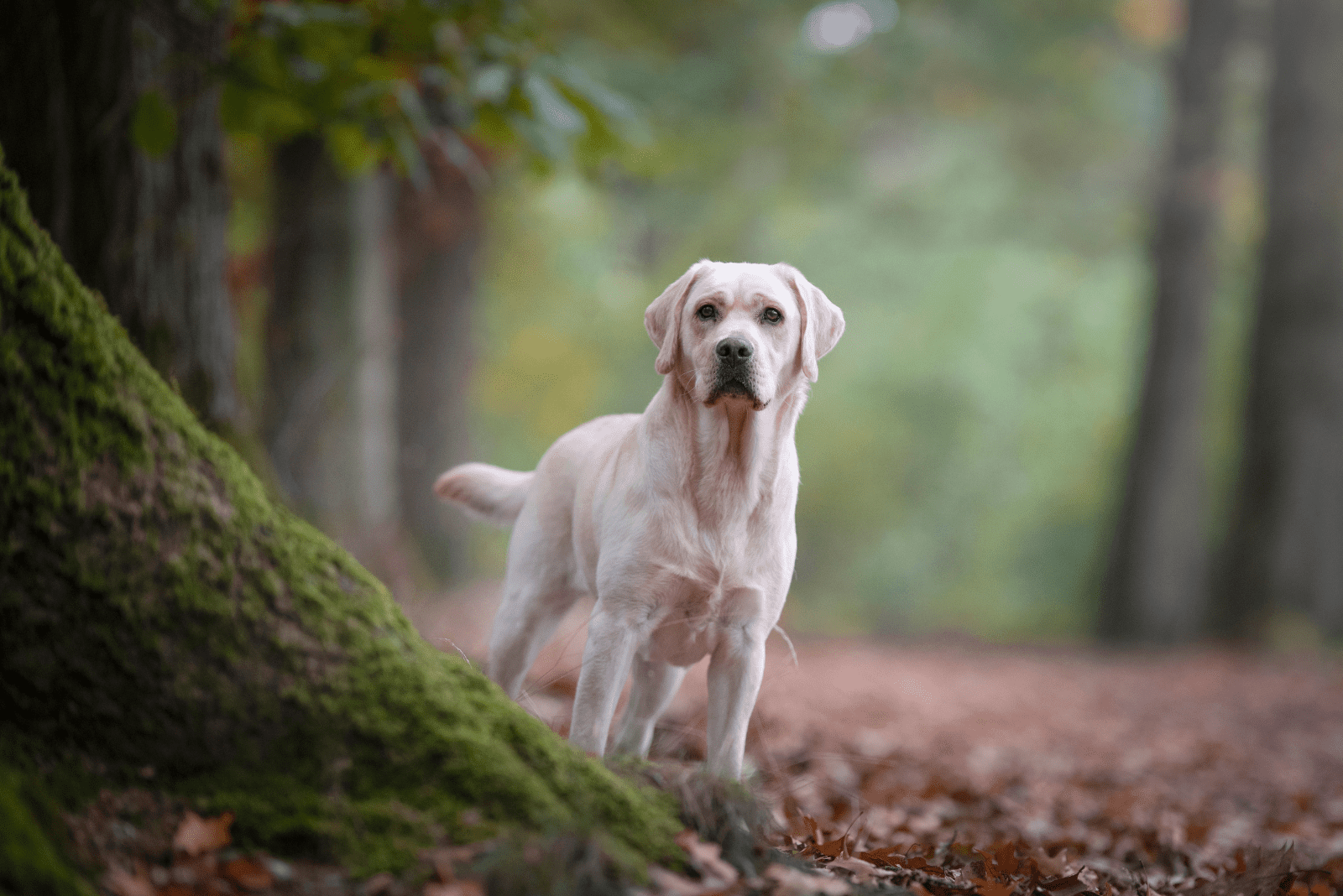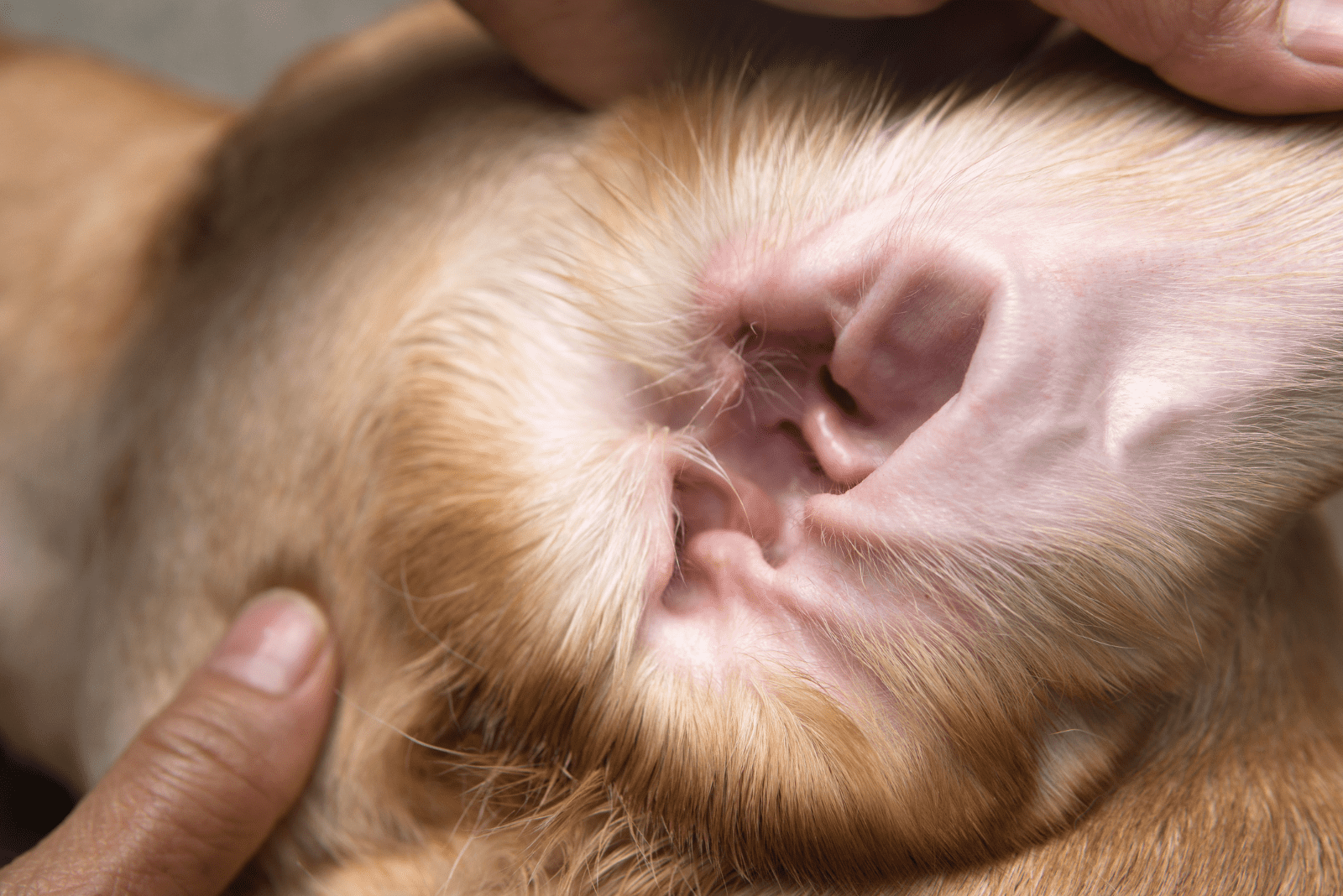Cropped ears are a topic of massive importance for both dogs and owners. It involves surgery that some consider necessary, and others consider a must in order to preserve tradition and aesthetics.
We decided to compile the most important information about Labrador ear cropping, tail docking, the whys and why nots, and comparisons to similar breeds and breed roles that influence cropping and/or docking decisions.
Is Labrador Ear Cropping A Thing?
If you tried googling “Labrador ear cropping”, you probably realized there are not many results. That is for good reason: the Labrador is most recognizable for its floppy ears. We could call this a convention.
Since the American Kennel Club, and other associations and clubs, deem floppy ears on a Lab a breed standard, conflicting opinions about Labrador ear cropping virtually do not exist.
The American Veterinary Medical Association agrees that there is no health benefit in it. We also agree, and we encourage dog owners to put animal welfare first.
Let us not forget how silly Labs look with hanging ears. Erecting their ears would transform them into a dog mashup.
To further explain this, we need to meet the Labrador retriever’s ancestor and learn a bit about its original role.
The Dog Ear That Listens To Your Wishes

Labradors are extremely sensitive to their owners’ needs. They are energetic, they love their family, and they require a lot of attention.
This is only a testament to their willfulness in performing the main duties that their breed was created for – retrieving.
Legacy of Labrador Retrievers
Hailing from Britain, the Labrador retriever’s origin stems from the St. John’s water dog. This breed inhabited Canada’s Newfoundland region before becoming extinct. Their job was pulling carts and logs, so they were working dogs.
Once the United Kingdom started importing and mixing the St. John with other breeds, the dog we know today started taking shape. It became the go-to dog for hunters, and nowadays, they are incredible service dogs.
This does not decrease their value as companion dogs, which perhaps is the most frequent role they play now. This is where looking cute picks up points.
That Water’s Got Me Looking Crazy Right Now
Talking about water in front of a Labrador will cause ceaseless excitement until it is soaking wet and muddied. Of course, we do not claim that every Lab loves water, but most do.
Genetic inheritance from its Newfoundland cousin made sure that being a great gun dog retriever meant owner satisfaction, and in turn, happiness for the Lab!
Such Floppy, Very Lab!
Breeding for a certain purpose means that every feature serves a purpose. The floppy ears have a protective role for the Labrador. Doing their job mainly around bodies of water, the Lab’s hanging ears prevent water from gushing into the ear canal.
That is not all, folks! These magnificent flaps work as a barrier that shields the ear canal from dirt and debris.
Although there is proof of domestication being the reason behind weakened ear muscles and issues in proper cartilage formation in Labradors (and other animals with floppy ears), studies have shown that health issues, such as ear infections, are not more likely to occur in such dogs.
Two Reasons For Ear Cropping
Oftentimes, we find ourselves deciding between two options and rationalizing both based on our experience. What if you have never had any experience relevant to the choices at hand?
This is especially hard with a canine companion that cannot give you their opinion, and the brunt of the decision rests exclusively in your hands.
We are here to give you all the necessary information and help you nail down that decision. Shall we?
Beauty Is In The Eye Of The Beholder

What one considers beautiful is entirely a matter of preference. Body alteration procedures, such as ear cropping or docking a dog’s tail can drastically change the visual perception of a dog.
A frequent element that people base their dog choice on is physical appearance. There is nothing wrong with that and, in most cases, the dog’s looks mirror the role they were genetically cultivated for.
If you have ever seen a Doberman pinscher without cropped ears, then you know they have a completely different impression with flaps on and flaps off.
The same goes for other dog breeds that have a pedigree of cropped ears. An adult boxer without cropped ears might look like a 40-year-old dressing like a 90s teenager, and a Schnauzer’s guard dog instinct might be better hidden behind hanging ears.
Cosmetic reasons undoubtedly have a big role in ear cropping procedures, and if your goal is to take the dog show by storm, by all means, go for it.
The AKC joined the chat. Their opinion is that ear cropping and tail docking for cosmetic purposes plays a role in upholding breed tradition and appearance, which is a valid argument for a kennel club.
Every dog is unique in character, and not every dog will react the same after surgery. With Labradors being a very sensitive breed, it is even more important to decide well.
These Ear Cropping “Facts” Are False
Unless imperative for our health, surgical procedures are not something that any of us want to undergo. Similarly, our dogs would avoid surgery if possible.
You must have heard one or two “facts” about ear cropping being the only solution to a dog’s ear problem. Most of them are hearsay, and have only gained popularity for whatever reason.
Let us work our way down the list of myths about cropping.
Floppy Ears Make Their Hearing Worse
If you ever owned a dog, especially one with floppers, a laugh is in order. Dogs’ hearing is infinitely better than ours. If you do not believe us, just try it right now.
Take a bag of your favorite snacks and see a Lab teleport to your location. As far as we know, they do not have X-ray vision, so it is their excellent hearing that helps them recognize the sound.
Though hearing loss is not uncommon in dogs, it happens mainly due to old age or congenital issues. Your dog’s floppy ears will not hinder its hearing.
No Ears Hanging? No Ear Infection
Studies have shown that more extreme cases of hanging ears can provide a moist environment for bacterial growth. Still, there are no studies confirming that cropping helped cure or reduce the chances of recurrence.
A great example of this inaccuracy is the Beagle – they have floor-mopping ear length, with one of the lowest rates of ear infection incidence. On the other hand, Cocker Spaniels are known for their susceptibility to ear infections.
The AVMA uses Dalmatians as an example of a dog breed whose ear cropping tradition disappeared and was not followed by an increase in ear infection cases.
Another myth-busting example is the German shepherd dog. They are known for their wolf-like erect ears, but are among the breeds that are most impacted by ear infections.
Many animal medical associations are pushing to educate owners that certain health conditions are associated with the breed of dog more than a dog’s physical features.
This health issue really comes down to potential congenital conditions, hygiene, and/or injury. As much as ear cropping is your decision, taking care of your dog should be, too.
Breed Standards Made Me Do It
Want to test yourself and your dog in a dog show? Then, you have to go through with cosmetic surgery whether you like it or not. Many kennel clubs require their participants to abide by specific breed standard appearances.
Take Pitbulls, great Danes, or Cane Corsos for example – dog clubs or shows in America will not accept any of those breeds unless their ears are cropped and/or tail docked. For Labradors, of course, the standard is to let them hang out.
If we consider what purebred means, then surely modifying the dog’s appearance means that we are striving towards a look that is different from purebred.
Some breeders, depending on the puppy’s age, will sell their dogs with their ears already cropped or their tail already docked. Inform yourself on the breeder’s policy in advance.
Ear Cropping Is All Gain, No Pain
The thing is… that is entirely false. If you ever had a deep cut on your face or your earrings caused your ears to swell, you know about pain. Now, imagine a portion of your ear being cut off just to look more like an elf.
Ear flaps are natural and they do not lower the dog’s quality of life. Bringing a dog to the veterinarian for an unnecessary procedure is considered animal cruelty. In fact, the United Kingdom and Australian kennel clubs oppose ear cropping and tail docking with appropriate legislation in place.
Cropping itself, if done ethically, is performed under a general anesthetic. This way, just like humans, the dog does not feel the pain of the surgery.
Post-operative complications can occur, and the recovery period is fairly painful, too. In addition, you will probably have to use ointments and painkillers to alleviate the pain. A cone is also a must!
Clearly, all of this is a burden on both the dog and yourself, taking the time of day that could be better spent in fun, bonding activity.
Neutering And Ear Cropping Are Both Body Alterations
The upsides of ear cropping have already been mentioned, and for healthy dogs, they are nonexistent. Why are these two even compared, then?
Some people who are proponents of ear cropping and tail docking believe that neutering is also body altering, and that the latter should not be done either if animal welfare is a primary concern.
This argument is without foundation, and here is why. There are several benefits to neutering a dog:
– It prevents testicular and ovarian cancer, and pyometra (uterine infection in unspayed dogs)
– It prevents dog overpopulation, which lowers the number of dogs that need to be put to sleep
– It raises pet owner awareness about dog abandonment and uncontrolled breeding
We are definitely not saying that neutering is something you must do, but there are some clear signs that indicate that your dog should be neutered. Furthermore, if you do not plan on having your dog reproduce, then we absolutely recommend that you neuter it.
Read Next: Why Labradors Are The Worst Dogs +5 Things To Change That
Procedure + Recovery Explained, Along With Price

Before going into details about the cropping procedure, it is important to note that dogs should have it done between weeks six and 12. The rule of thumb is: the sooner, the better.
Six-week-old puppies have a considerably lower chance of remembering the traumatic experience as opposed to a twelve-week-old puppy.
Ear cropping in an adult dog is borderline unethical, and it can negatively impact your relationship with your dog.
Some dogs, especially breeds like the Labrador, which are very sensitive to external stimuli, can become detached and behave unpredictably if exposed to the procedure in adult life.
The Surgery Explained
The ear, along with the area around the dog’s head, are thoroughly cleaned prior to the surgery. Then, the vet will precisely measure and mark the region of the ear to be cropped.
After administering general anesthesia, the veterinarian will remove part of the pinna or auricle. This is the outer part of the ear resembling a shell. A certain part of the ear will be cut off depending on the breed of dog and the “styles” of crop available.
Stitches are then applied to close the contour of the ear, and since the healing process is longer than less-intense surgeries, the sutures will probably be synthetic. This means another vet visit to remove them.
Complications are possible, and they include excessive bleeding, scarring, susceptibility to post-op infection, sensitivity, and even a failed crop, causing your dog’s ears to look unnatural and/or not be fully erect.
If you are not satisfied with the work the vet has done and/or your dog’s health is compromised, visit an animal hospital and ask for more expert care.
Post-op Recovery Process
The vet might prescribe non-steroid painkillers and topical treatment. If you wish to use some natural home remedies, make sure you consult the veterinarian.
Your dog will have to wear a cone because scratching will open the wound. Opening the wound can cause an infection, and that is a setback you do NOT want.
Depending on your dog’s healing ability, you might have to slightly change its diet or increase its supplement intake. Once again, this should be done after consulting the veterinarian who performed the procedure.
Additionally, you will have to gently remove scabs from your dog’s ear to avoid infection and deformation.
Taping and posting will be required to preserve the ear’s newly-created shape. This includes creating a post built out of bandages or some other non-abrasive fabric and taping it to the ear. The post should go from the ear root until it passes the ear by roughly a quarter length.
The process should be done until the ear is perfectly erect without folding. If the ear does not stay erect even after several weeks of posting, you should go to the veterinarian.
Money Talk And Choosing The RIGHT Vet
Ear cropping is not a cheap pet “upgrade”. Though costs vary, the price ranges from $180 to $700. You might think that the amount of dollars is directly proportional to the quality of service, but that is where you need to be careful.
Many veterinarians nowadays refuse performing ear cropping or tail docking so you might be left with fewer choices. Other veterinarians do these procedures more often, and they can be a safer choice.
Other veterinarians occasionally accept the odd ear crop or tail dock. Always bring a reference picture of the crop you want your dog to have so that both you and the vet are on the same page.
Depending on the breed, vets can be better at particular types of cropping, and worse at others. That is another thing to consider.
You can ask the breeder, kennel clubs, or people you know who have dogs with cropped ears for vet recommendations.
Cropping To The Conclusion
Okay, you are probably not going to go through with the idea of Labrador ear cropping since it is neither recommended nor established as a breed standard. The same goes for any dog that might have no competitive or health advantage from this procedure (the Rottweiler comes to mind).
Long gone are the traditions of cutting ears and the tail for dog fighting, hunting, pulling, and other obsolete dog jobs. Even if you are considering dewclaw removal for “practical” purposes, it does make for a pricey superfluous deduction.
Another thing to keep in mind is the recovery period. It is LENGTHY and frustrating for both owner and dog. We are adamant that those weeks of painkillers, ointments, vet visits, and scab removal can be better spent by trips to the beach, the mountains, or good old tummy scratching on the couch.
In any case, what we are trying to say is think your decision through, see what you and your dog gain and lose by having this type of surgery done, and consider your dog’s welfare first.
Read Next:
• What Is A Bait Dog? The Ugly Truth
• 19 Dog Breeds With Rose Ears – A Rose For Everyone’s Garden
• 5 Facts About Dog Ear Piercings To Poke Your Conscience
